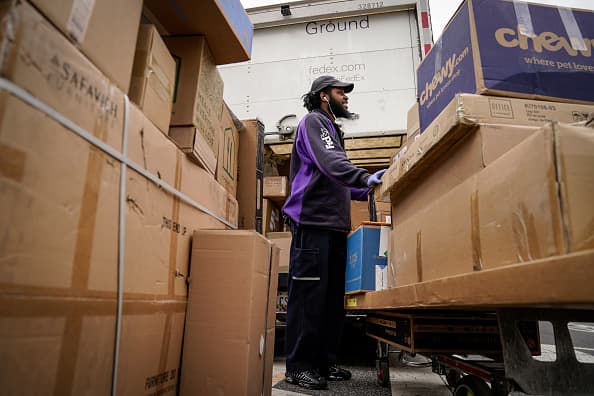A FedEx worker unloads packages from his delivery truck on March 31, 2020 in Washington, DC.
Drew Angerer | Getty Images
Following a rush for groceries and cleaning supplies, more Americans are looking to crack open a book.
As people remain sheltered in their homes due to the coronavirus outbreak, online shopping has surged as a replacement for an old-fashioned trip to the store. In addition to the overall boom in e-commerce spending, sales data reveals that following an initial stockpiling of goods, many online shoppers have shifted their focus to entertainment products such as books and games as they adjust to the new normal of life in quarantine.
E-commerce spending in the U.S. is up more than 30% from the beginning of March through mid-April compared with the same period last year, according to market research firm Rakuten Intelligence. That is significantly more growth — about 50% more — than the annual 20% growth in online shopping the firm has become accustomed to seeing in recent years.
This snapshot of the economy paints a picture of both what Americans are buying and how shopper priorities have shifted over the course of the extended quarantine period.
It also offers a stark contrast to recently released figures on U.S. retail sales, which include estimates for brick-and-mortar businesses. The 8.7% plunge in March was the biggest decline since the government started tracking it in 1992.
An initial surge in online ordering appears to have been driven by a run on staples as it became increasingly likely that people would be staying home for the foreseeable future.
“There has been huge stockpiling in March in the U.S.,” said Sucharita Kodali, a retail analyst with the research firm Forrester. She listed health products, pet supplies and home office equipment as items that were frequently bought in bulk as states began to issue stay-at-home-orders in mid-March.
Jewelry and apparel sales declined
Data on e-commerce shopping by category from Rakuten Intelligence backs this up. Much of the overall e-commerce growth has been driven by household cleaning products and grocery items, according to Jaimee Minney, senior vice president of marketing and public relations at Rakuten Intelligence.
In fact, some of the largest online grocery shopping days Rakuten Intelligence has tracked occurred in March 2020, Minney said. More than half of all items ordered between March 2 and March 15, fall into the “grocery and gourmet food” category.
But the data also show the extent to which U.S. consumers are relying on online ordering beyond products for food and safety, with large annual gains in everything from baby products to pet supplies to home office equipment. Jewelry and apparel were the only two of the 20 categories tracked to show a decrease in online spending in March and the beginning of April. According to Minney, “people aren’t as inclined to buy new outfits that people aren’t going to see them in.”
Amazon sales are not included in the data, but Rakuten Intelligence tracks nearly all other major companies that sell online.
Following the initial stockpiling period, there was a shift in spending preferences over the past six weeks. This is something that Kodali referred to as “cadences” in buying behavior throughout the coronavirus pandemic.
The next wave: Beyond basics
“Things come and go in waves,” Kodali said. “It can be rumor driven. When people hear stories about there being a shortage on something that they might need, they will stockpile.”
Minney said she saw evidence of “panic buying” during the earliest and most unfamiliar periods of the virus outbreak, referencing toilet paper as a now-familiar example. But she also said that at this stage in the pandemic, some are starting to focus on a different set of needs.
“It went from people trying to stock up and maybe buying a little bit more than they needed to understanding that things are OK, I can move beyond the basics of food and shelter,” she said.
A closer look at the shopping data illustrates this shift. Comparing the first half of March, before stay-at-home orders were issued in the U.S., to the first half of April, many of the items showing the largest growth in dollars spent go beyond the essentials. Despite being a fraction of the overall share of spend, there was a whopping 777% increase in book purchases, followed by 182% growth in the toys and games category and 131% growth among sports and outdoors items, which includes gym equipment. Home improvement (71%) and health and beauty (38%) products follow close behind.
Meanwhile, spending on grocery items and cleaning supplies appeared to taper off. The grocery category, for example, increased at only a 25% clip in the first half of April compared with growth of more than 100% year-over-year. That said, that slowdown could be influenced by the fact that many shoppers have struggled to find in-demand items across the web. ”Some of those products became harder to come by,” said Minney.
At the same time, many Americans have fallen on hard times financially and may be limiting their purchases of discretionary items, as more than 22 million people have filed for unemployment over the course of the Covid-19 crisis. But those who can afford it, appear to be reaching beyond the basics of groceries and household items in an effort to find ways to pass the time in quarantine, a phenomenon Minney expects to continue in the coming weeks and months.
“There’s sort of this trend toward self improvement and using this time constructively,” she said. “Book sales increase, games and puzzles, and we have seen health and beauty start to grow as well, especially when you look at it on a year- over-year basis. That’s one I might keep an eye on, the self-improvement piece.”
